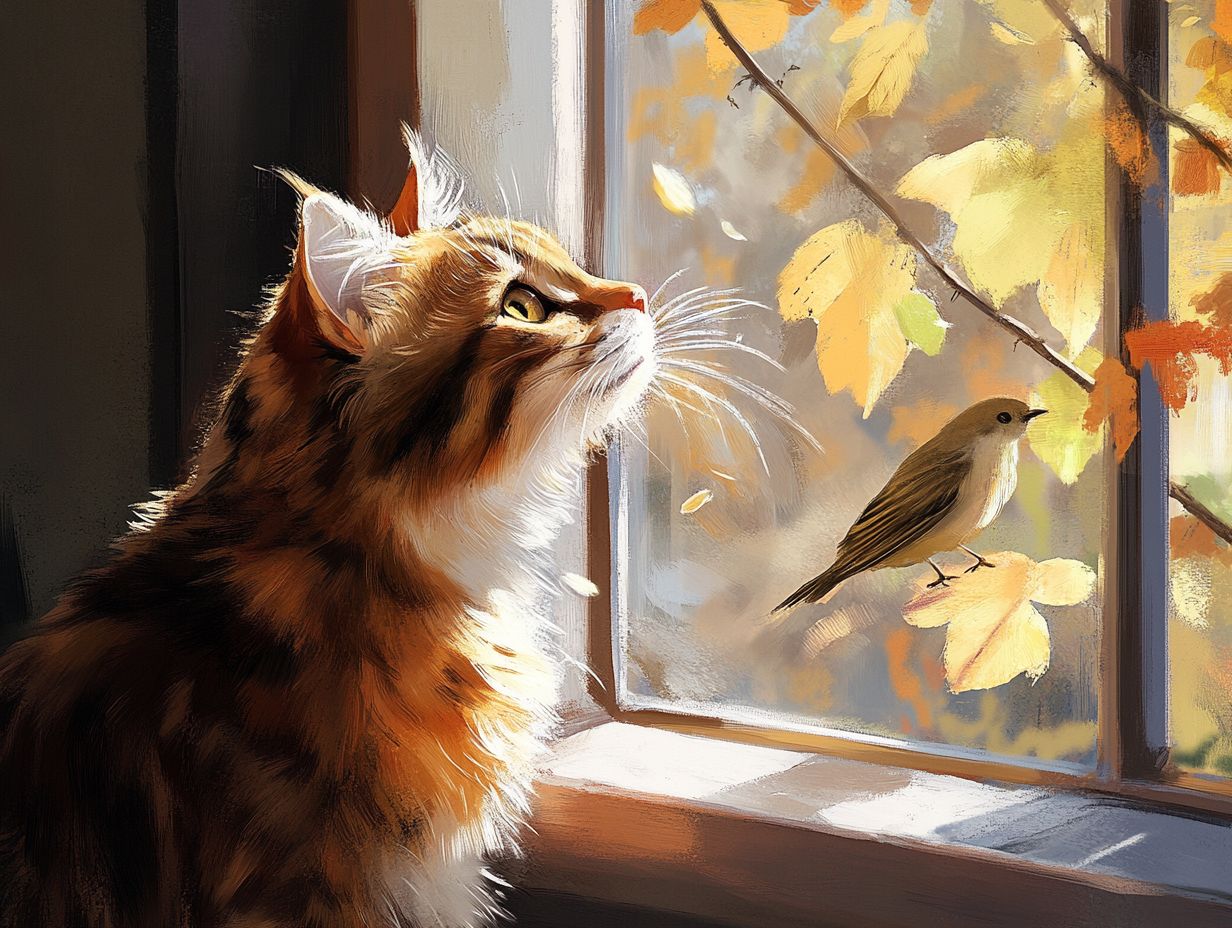Have you ever heard your cat make a chattering sound and wondered what it means? This intriguing behavior is more than just a quirky habit—it’s a window into your feline friend’s instincts and emotions. Understanding cat chattering can strengthen the bond between you and your cat by fostering better communication and mutual understanding.
This article explores what cat chattering is, why cats chatter, and whether it’s a normal behavior. It also discusses its potential downsides, like frustration expression, and offers tips on how to manage it effectively, such as using interactive toys and providing environmental enrichment.
Get ready to decode the chatter and deepen your understanding of your beloved companion!
Key Takeaways:
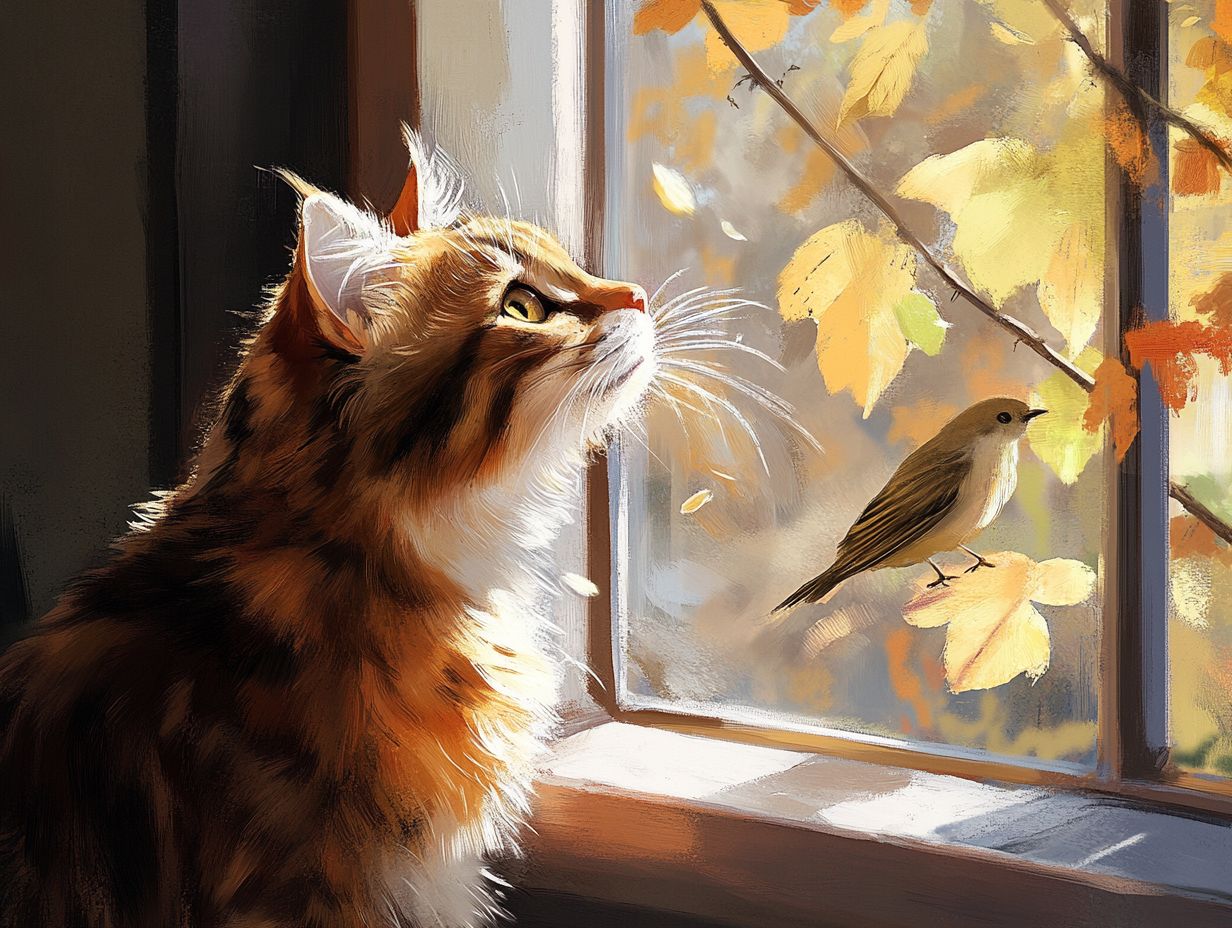
- Cat chattering is a common behavior in felines that can be triggered by instinct, hunting, excitement, or communication.
- It is important to monitor the frequency and duration of chattering and any changes in behavior to ensure it is not harmful.
- Chattering may vary across different life stages (kittens, adults, seniors) and can reflect individual variation among breeds.
- To prevent potential harm, provide appropriate toys, distract with treats, train with positive reinforcement techniques, such as clicker training, and consult with a veterinarian if necessary.
- Addressing stress and anxiety can mitigate excessive chattering, especially in multi-cat households.
What is Cat Chattering? Common Cat Behaviors Explained
Cat chattering is a distinctive sound made by cats; it is short, repetitive, and resembles a combination of a chirp and a trill. This behavior is often observed in cats that are watching birds or small animals outside a window, reflecting their instinctual behaviors and hunting instincts.
Chattering can indicate excitement or frustration and highlights the complex nature of feline vocal communication within the context of hunting instincts and engagement with prey. It’s essential to interpret this behavior from a cat’s perspective, as it reveals their natural instincts rather than human emotions.
Why Do Cats Chatter? A Look into Feline Communication
Cats chatter for several reasons, primarily as a reflection of their natural hunting instincts, which are deeply ingrained in their biology. This behavior often occurs when they see birds or small animals, typically in response to excitement or frustration.
Chattering showcases the complex emotional and psychological states of cats. As a form of cat communication strategies, it offers valuable insight into a cat’s mind. Understanding this behavior can enhance a cat’s mental stimulation and overall well-being.
1. Instinctive Behavior
Instinctive behavior plays a crucial role in cat chattering, serving as an innate expression of their hunting abilities and predatory skills, which have been encoded over thousands of years. This behavior illustrates that domesticated cats retain a strong instinctual drive to hunt, maintaining a connection to their wild ancestors even when raised in a home environment. This connection is evident when observing a cat’s visual focus during chattering at the window.
When a cat chatters at birds or small animals outside, the sounds often mimic those made by its wild forebears. This vocalization is frequently used as a means of communication, expressing excitement and frustration, much like the calls of larger wild cats stalking their prey.
These sounds reflect a complex blend of eagerness and frustration directed at prey that is out of reach. The similarities between domesticated cats and feral ones highlight the persistence of instinctual behaviors and underscore how deeply embedded hunting instincts are in the feline personality, regardless of whether a cat lives in the wild or in a home setting.
2. Hunting Technique
The chattering noise that cats make may be a form of hunting behavior, where they imitate the sounds of their prey to elicit a response. This behavior exemplifies their natural instincts and illustrates the complex ways in which cats engage in hunting, even when they are merely observing from behind a window.
When they produce this sound, felines are likely trying to capture the attention of their prey, thereby increasing the chances of a successful catch in a natural environment. This instinctual form of communication highlights the importance of awareness and perception in their predatory instincts.
For indoor cats, these chattering moments serve as a clear indication of their ancestral behaviors, connecting them to their wild relatives. Observing this behavior can also help owners recognize their cat’s need for mental stimulation, underscoring the importance of providing sufficient enrichment in indoor settings to keep them satisfied. Simple modifications, like creating perches or providing views of wildlife, can enrich their environment.
3. Excitement or Frustration
Chattering is a vocalization that cats produce when they are excited or frustrated, typically while observing birds or other potential prey. It is crucial to recognize these vocalizations as symptoms of underlying states like boredom or anxiety, prompting owners to take preventive measures early on.
To address excessive chattering, consider identifying triggers and implementing gradual desensitization techniques. Moreover, a thorough check for any medical issues is vital before concluding that chattering stems solely from instinct.
This chattering can express happiness and may indicate a heightened adrenaline response, reflecting their natural instincts and cognitive processes linked to their emotional state and joyful chattering.
4. Mimicking Prey Sounds
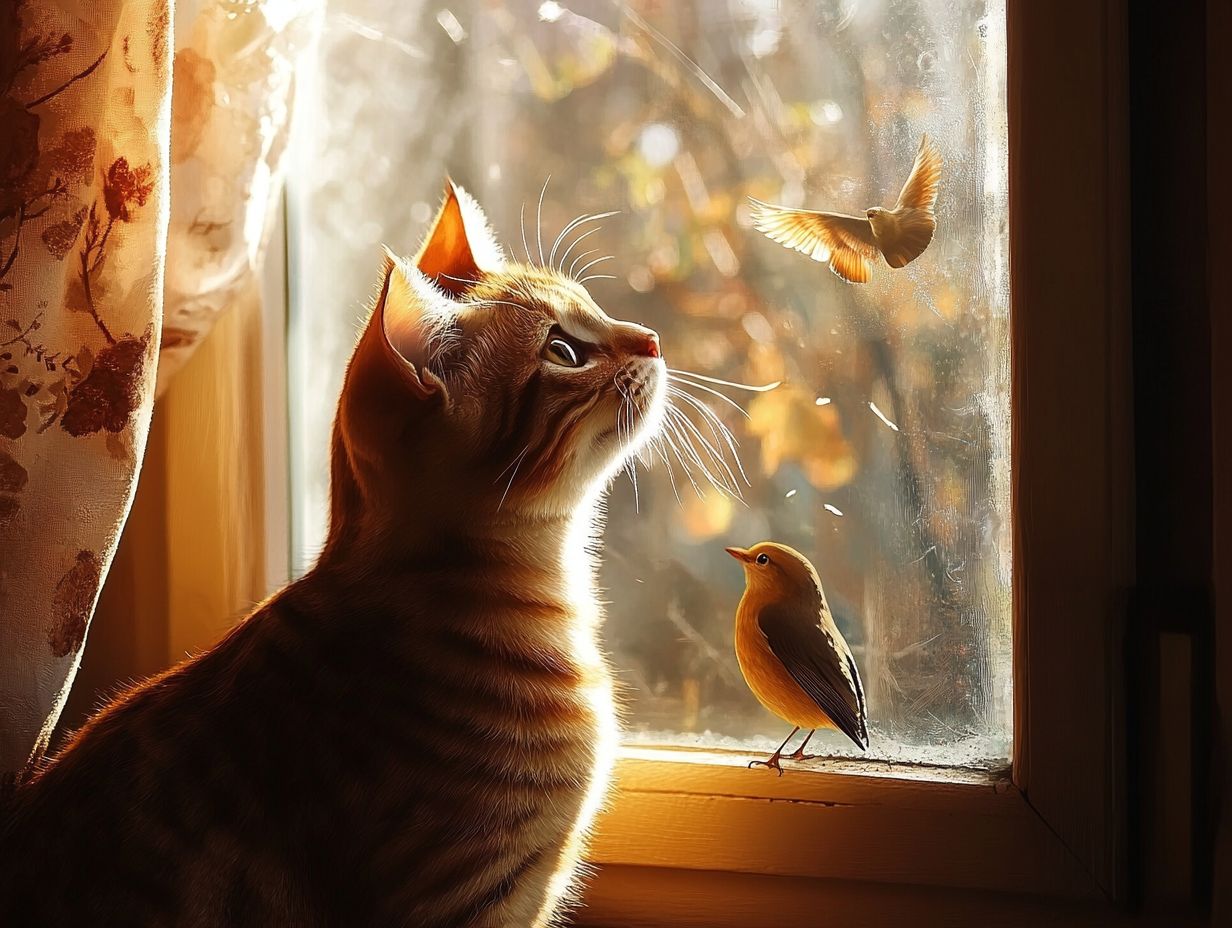
The ability of cats to mimic prey sounds during chattering is significant for their hunting success. By imitating the sounds of birds and rodents, cats create a visual stimulus that captures the attention of their prey, highlighting their vocal repertoire. This behavior is observed across different developmental stages—kittens, adults, and seniors may exhibit variations based on their life experiences and cognitive development.
When a cat chirps or chatters, it generates an auditory illusion that can trigger a primal instinct, inciting curiosity in nearby animals. This behavior is not merely entertaining; it forms a crucial part of their hunting strategy. By mimicking the sounds of potential prey, cats can approach stealthily without raising suspicion, thereby increasing their chances of a successful catch.
This complex form of communication highlights the evolutionary adaptability of felines, demonstrating how they have learned to navigate the challenges posed by their environment. Individual variation, influenced by factors like breed, genetics, and past experiences, can affect a cat’s chattering frequency and context.
5. Communication with Other Cats
Cats use chattering as a form of communication with one another, employing vocalizations that convey their emotional states and social behaviors. This behavior is particularly evident in multi-cat households, where vocalizations help establish social hierarchies. Observations of chattering can reveal insights into their communication signals and behavioral patterns.
In this context, chattering expresses excitement, annoyance, or predatory instincts, with different sounds used depending on the situation. These vocalizations strengthen social bonds by enabling cats to communicate territorial boundaries, playful intentions, or signals of distress. It’s essential to recognize that chattering can differ among cats in these environments and to provide tips for introduction and resource sharing.
Observing how one cat reacts to another’s chattering can provide valuable insights into their social structure and individual temperaments. Understanding and responding to chattering can strengthen the bond between cats and their owners.
Is Cat Chattering Normal?
It is important for cat owners to understand whether cat chattering is a normal behavior, as this can depend on various factors, including the cat’s environment, daily challenges, and overall health status.
Typically, cat chattering is a natural expression of instinctual behavior; however, owners should remain attentive to any noticeable changes in their cat’s behavior, as these can signal underlying issues. Consulting a veterinarian or cat behavior expert can provide valuable advice and help rule out medical causes when observing changes in chattering.
1. Frequency and Duration of Chattering
The frequency and duration of a cat’s chattering are crucial factors in determining whether its behavior is normal. Some cats chatter more than others, depending on their individual vocalization habits and the environmental stimuli they encounter. For instance, a cat that chatters for extended periods may be expressing excitement, while a cat that chatters less frequently might display a more nervous or apprehensive demeanor.
By observing these patterns, owners can differentiate between the normal sounds their cat makes and those that may indicate heightened stress or concern. Recognizing the differences in chattering among various felines is essential for accurately interpreting their emotional and psychological states. Changes in the environment, such as the introduction of new pets or alterations in daily routines, can significantly impact a cat’s behavior and should be considered when evaluating its vocal responses.
2. Changes in Behavior
Monitoring changes in a cat’s chattering behavior is crucial, as increases or decreases may signal underlying issues, including stress or medical problems. This highlights the importance of pet owners being vigilant for changes in their cat’s behavior. Regular veterinary check-ups and attention to potential physical changes are recommended to promote optimal pet wellness.
When a cat experiences changes in chattering, it may also exhibit alterations in other behaviors, such as eating, grooming, and overall activity levels. For instance, a cat that no longer chatters while playing may subsequently stop eating, which could indicate physical pain or emotional distress.
Understanding the connection between behavior and health is vital. Early intervention for behavioral changes can prevent issues related to chattering, and owners should implement proactive strategies to create a calming environment.
Can Cat Chattering Be Harmful?
Addressing potential problem behaviors related to chattering, such as excessive chattering during stressful situations, is essential. Owners should seek professional help when necessary, outlining the roles of veterinarians and animal behaviorists in assessing and addressing chattering issues.
To foster a positive environment, owners can engage with their cats through play or rewards when they observe chattering, while refraining from punishment, as it could lead to negative behaviors. Environmental enrichment ideas that promote natural hunting behaviors, such as puzzle feeders and interactive toys, can stimulate chattering.
By understanding cat behavior through ongoing learning, owners can explore resources such as books, websites, or courses that delve deeper into feline communication and behavior management, creating a more harmonious relationship with their pets.
Cat chattering is generally a harmless behavior; however, from a cat’s viewpoint, excessive chattering may indicate feelings of frustration or stress. It can become problematic if it is linked to increased stress and anxiety or results in physical issues such as tooth damage. By understanding the potential negative consequences of this behavior, pet owners can create a more enriching and supportive environment for their cats, ensuring proper environmental enrichment and addressing daily challenges.
1. Tooth Damage
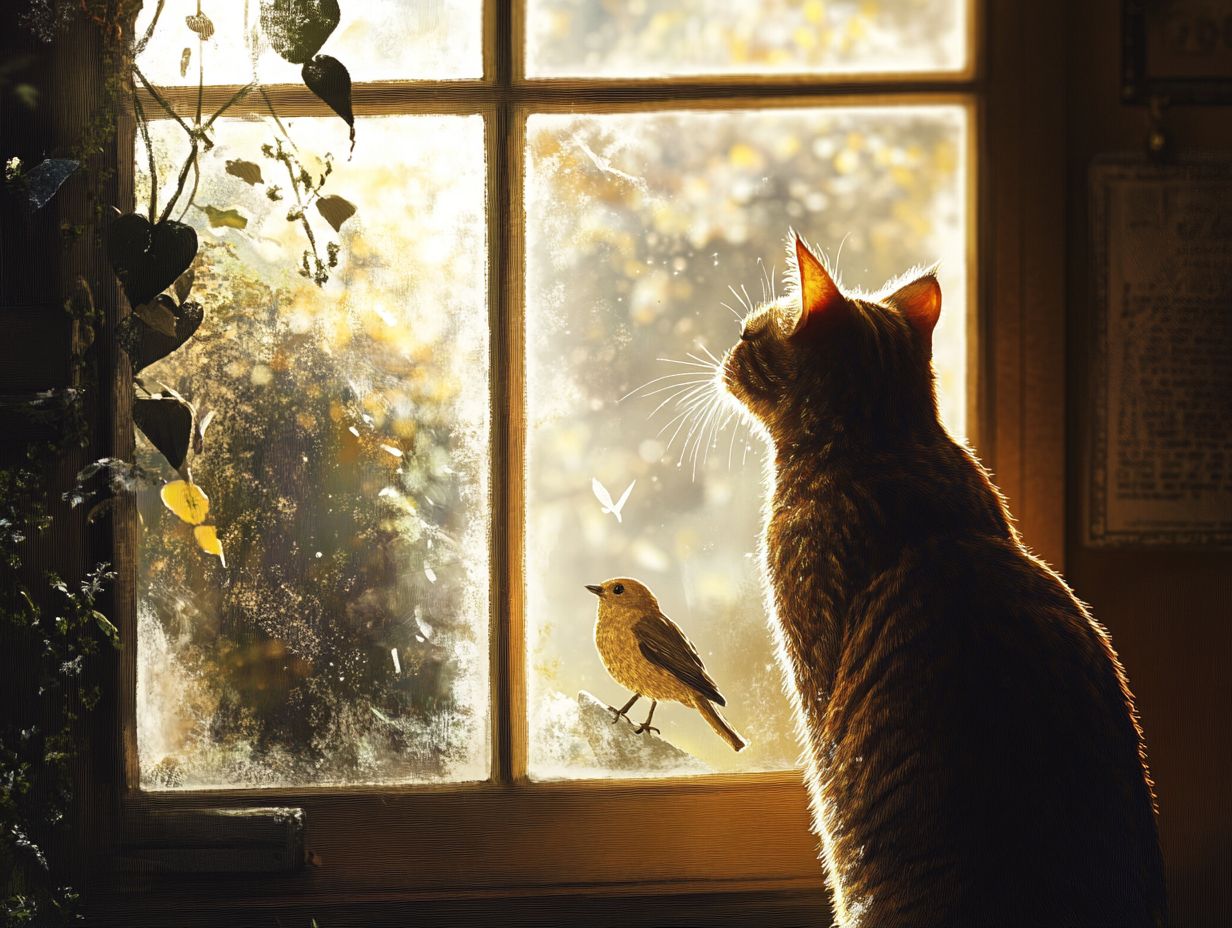
Excessive chattering in cats can lead to tooth damage, especially if it occurs frequently due to stress or frustration. While chattering is a common and natural behavior, excessive occurrences can pose a risk to dental health, making regular veterinary visits crucial for early detection of potential issues. Consulting resources like the Journal of Feline Medicine and Surgery can provide evidence-based insights.
Cats typically chatter by rapidly moving their jaws back and forth, which can gradually wear down enamel and cause misalignment. Prolonged exposure to stress may increase the frequency of chattering, further jeopardizing dental health. Over time, excessive chattering can lead to problems such as tooth breakage or periodontal disease, which may not be easily noticeable in their early stages. Pet owners should be vigilant for signs of dental issues, such as changes in eating habits or increased tooth sensitivity, and seek veterinarian advice to protect their pet’s dental health, which is a crucial aspect of overall pet wellness.
2. Stress and Anxiety
Stress and anxiety in cats can manifest in their emotions and behaviors, such as excessive chattering. This cat vocalization indicates that their emotional needs may not be met, highlighting the importance of understanding this connection for pet health. Addressing the underlying causes of stress can significantly enhance a cat’s quality of life. Vocalizations like chattering can be signs of a cat’s annoyance or irritation, particularly in environments that lack enrichment or sufficient interaction. This underscores the necessity for mental engagement and environmental enrichment to alleviate stress.
Providing a variety of toys, playtime with caregivers, and safe spaces for exploration are effective ways to nurture their instincts, helping them feel secure and content. Engaging in activities that align with their natural instincts, such as climbing structures or outdoor enclosures, can contribute to their mental stimulation. Observing their behaviors can offer valuable insights into their emotional well-being, enabling us to implement interventions that promote both their physical and emotional health.
How to Stop Cat Chattering?
If cat chattering is a concern, there are several methods that owners can use to reduce this behavior. These include:
- Providing more interactive toys
- Distracting the cat with treats
- Rewarding them during training sessions
By addressing the underlying reasons for chattering, owners can help foster a healthier balance in their cats’ lives, considering factors like daily challenges and instinctual behavior.
1. Provide Appropriate Toys
Providing appropriate toys, especially interactive ones, can help reduce cat chattering by engaging them both mentally and physically. Toys that stimulate a cat’s hunting instincts can distract them from the visual stimulus that triggers their chattering behavior. Interactive toys, such as feather wands, laser pointers, and motion-activated gadgets, effectively channel a cat’s energy, offering both exercise and mental stimulation. These toys simulate real-life scenarios that capture a feline’s attention, encouraging them to pounce, chase, and explore as part of their natural instincts.
Additionally, incorporating puzzle feeders that require problem-solving can further enrich their environment, preventing boredom and the resulting chattering. By offering a variety of engaging options, pet owners not only promote physical activity but also nurture their cat’s natural instincts, leading to a more balanced and contented pet.
2. Distract with Treats
Distracting cats with treats can effectively reduce their chattering when they spot birds or other small animals outside. This is particularly useful when cats exhibit frustrated hunter behavior. Using treats as positive reinforcement not only diverts their attention but also encourages calmer behavior. Positive reinforcement is more effective and humane than punitive methods, as it builds trust. Effective rewards include favorite treats or playtime with a beloved toy.
Understanding Chattering: A Feline Perspective
Chattering may vary by a cat’s age, with kittens chattering more due to playfulness, while seniors may do so due to cognitive decline. Individual variation also plays a role; some breeds may show a predisposition to vocalizations based on their hunting instincts. Understanding these nuances helps in addressing chattering behavior more effectively.
Behavior Modification Techniques
To reduce chattering, consider implementing clear, step-by-step training exercises that reinforce calm behavior during potential triggers. A strong bond with your cat can influence behavior positively, reducing anxiety and enhancing mutual understanding. If behavioral changes are sudden or severe, it’s advisable to consult a veterinarian or animal behaviorist.
Common Myths about Cat Chattering
It’s important to debunk common myths about cat chattering, such as it being purely a sign of aggression. In reality, chattering can signify various emotions, including excitement or frustration. Understanding these nuances can guide owners in responding appropriately to their cats’ needs.
For ongoing education, consider exploring resources like webinars or books focused on feline behavior. Regular veterinary check-ups are essential to rule out medical issues that may contribute to behavioral changes like chattering. Early intervention is key to preventing excessive chattering from becoming a habit.
These treats engage the cat’s senses with enticing smells and flavors, making them a valuable tool for promoting positive behavioral changes. Cats process these scents and tastes differently than humans, making their enjoyment of treats uniquely feline. When a cat focuses on a snack instead of the animal outside, it helps create a more relaxed environment, aiding in the management of visual focus and sound mimicry.
If used appropriately, this approach can gradually diminish their predatory instincts within the home. As cats learn to associate the sound of a treat bag crinkling with desired behaviors, it fosters trust, strengthens the bond between owner and cat, and ultimately leads to a happier, more content animal. This process can enhance social behavior and promote pet enrichment.
3. Train with Positive Reinforcement
Training cats using positive reinforcement techniques, such as clicker training or rewarding with treats, can effectively modify their chattering behavior, fostering healthier behavioral patterns and enhancing their overall well-being. By rewarding calm behavior and redirecting their focus, owners can successfully manage this vocalization, which is a part of the cat’s vocal repertoire.
This approach not only reduces unwanted sounds but also strengthens the bond between the pet and its owner. When a cat is consistently rewarded for remaining calm, it begins to associate tranquility with positive outcomes, aiding in the development of effective communication signals.
By implementing these strategies, caregivers can help alleviate stress and anxiety in their pets, creating a more peaceful home environment. The ripple effect of such training ultimately contributes to the cat’s mental well-being, making it not only an effective solution for chattering but also a vital component of comprehensive pet wellness.
In essence, the benefits extend well beyond mere behavior modification, enhancing the cat’s feline vocal communication. Additionally, it is important to recognize that chattering behaviors can vary based on the cat’s age (kittens, adults, seniors) and individual breed characteristics.
4. Consult with a Veterinarian
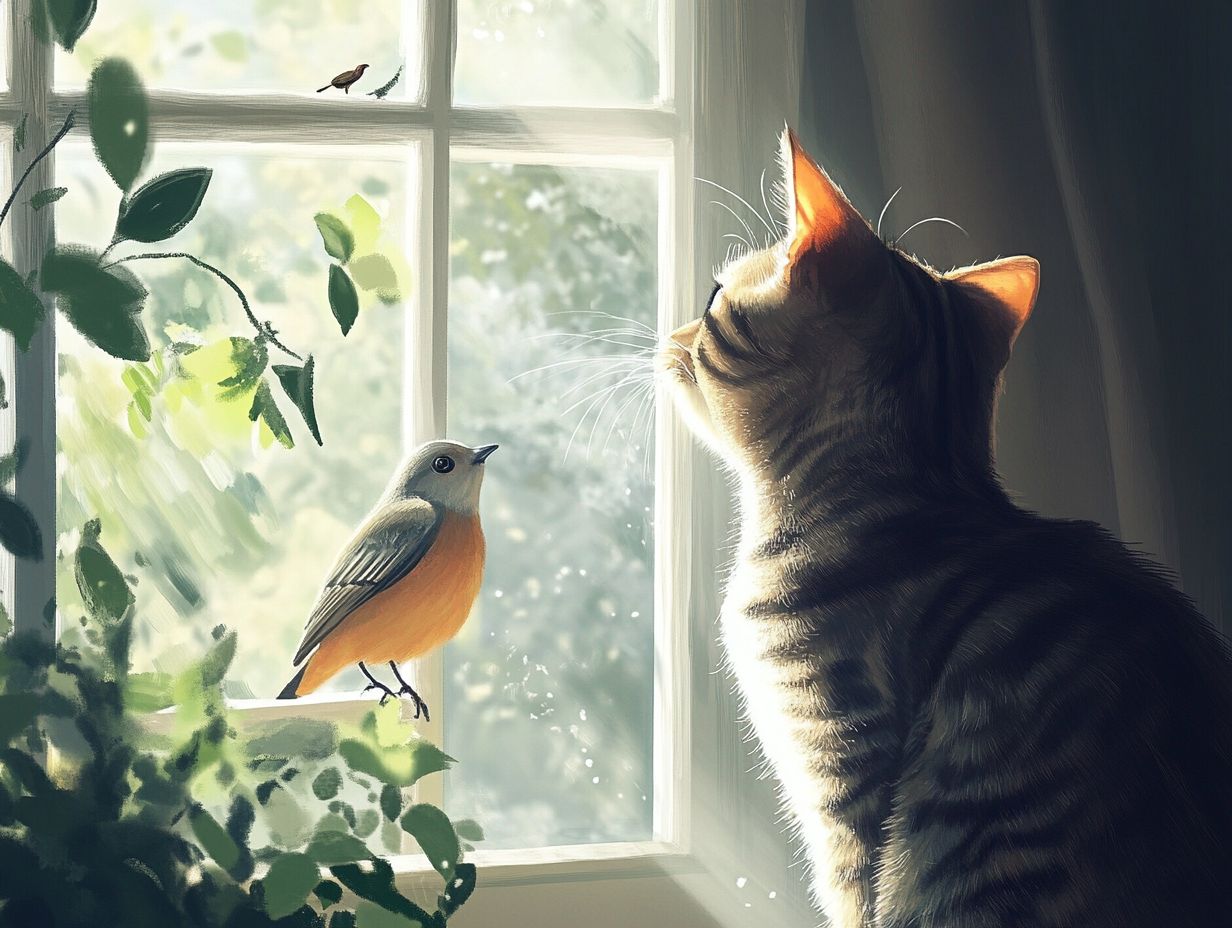
If cat chattering persists despite owners implementing intervention steps, it is advisable to consult a veterinarian to rule out any potential medical issues. A veterinarian’s expertise can provide insights into behavioral changes and guide owners on the best ways to support their cats and ensure their safety, considering factors like physical changes and adrenaline response.
While chattering is often harmless, it may also signal stress, anxiety, or even physical discomfort. Veterinarians can perform a comprehensive assessment of the pet’s overall health by examining factors such as diet, environment, and possible behavioral triggers, contributing to the understanding of common cat behaviors.
They can identify any underlying issues that may require attention and may recommend specific solutions or modifications to the pet’s routine to promote a happier, healthier lifestyle, enhancing pet enrichment and supporting domestic pets.
Frequently Asked Questions
-
Why Do Cats Chatter?
Cats chatter when they are focused on something they cannot reach or catch, such as a bird outside the window or a toy dangling on a string. This chattering at the window can reflect the cat’s hunting instincts and be part of their vocal expressions.
-
Why Do Cats Chatter Even When They Are Indoor Cats?
Indoor cats may chatter as a natural instinct, even if they cannot access the object of their attention. It may also be a sign of boredom or frustration expression.
-
Is Chattering a Sign of Aggression in Cats?
No, chattering is not a sign of aggression in cats. It is a form of feline vocal communication and a way for them to express their excitement or frustration.
-
Can All Cats Chatter?
While most cats can chatter, not all of them do. Some may not have developed the behavior, while others may be physically unable to do so due to dental issues or other health conditions, affecting their vocal repertoire.
-
Do Cats Only Chatter at Birds?
No, cats may also chatter at other animals or moving objects, such as insects or small rodents. It is their way of expressing their natural hunting instincts and engaging in cat communication strategies.
-
Is It Okay to Encourage My Cat to Chatter?
Encouraging chattering can be fine as it allows cats to express their natural instincts. However, it’s important to provide environmental enrichment and safe activities to reduce stress and anxiety, which can contribute to excessive chattering.
For further education on feline behavior and training, consider checking reputable resources, books, and online courses that focus on ethical treatment and training methods. Recognizing the signs of stress, such as hiding or sudden changes in behavior, is crucial for promoting a positive environment for your cat.
Yes, it is perfectly fine to encourage your cat to chatter. Research indicates that chattering is often linked to instinctual hunting behaviors, where cats express excitement or frustration related to prey (source: Feline Behavior: A Guide to Understanding Your Cat by John Bradshaw). You can encourage this behavior by providing stimulating toys, such as interactive ones that mimic prey, or by creating a rich environment for exploration, which supports their joyful chattering and playful behavior.
Understanding chattering from your cat’s perspective is essential. This behavior can signal their excitement or frustration as they engage with their instincts. Additionally, chattering may vary among kittens, adults, and senior cats, with younger cats typically expressing this behavior more frequently due to their higher energy levels. However, individual variation plays a significant role; not all cats will chatter equally based on personality traits, breeds, and past experiences.
When encouraging chattering, consider both physical and emotional factors. Setting up play areas that mimic natural hunting scenarios can provide enrichment. Observing your cat’s body language—such as tail position and ear orientation—can help interpret their emotional state during these moments.
While chattering is a normal behavior, excessive chattering may indicate underlying issues such as stress, anxiety, or frustration. If you notice a change in their chattering frequency, it is advisable to consult a veterinarian to rule out any health concerns.
Engaging with your cat during these chattering moments can enhance the human-cat bond, paving the way for positive interactions. It’s crucial, though, to be mindful of the ethical implications of encouraging certain behaviors and ensure that stimulation does not lead to frustration or anxiety.
Continuing to learn about feline behavior is beneficial. For further information, consider exploring resources from reputable veterinary behaviorists or feline behavior courses to better support your cat’s well-being.
